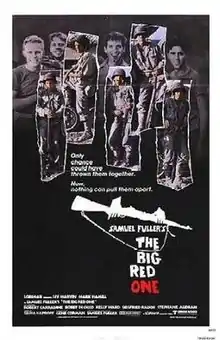The Big Red One
The Big Red One is a 1980 epic war film written and directed by Samuel Fuller, and starring Lee Marvin alongside an ensemble supporting cast, including Mark Hamill, Robert Carradine, Siegfried Rauch, Bobby Di Cicco, and Kelly Ward.
| The Big Red One | |
|---|---|
 Theatrical release poster | |
| Directed by | Samuel Fuller |
| Produced by | Gene Corman |
| Written by | Samuel Fuller |
| Starring | |
| Music by | Dana Kaproff |
| Cinematography | Adam Greenberg |
| Edited by | Morton Tubor |
Production company | |
| Distributed by | United Artists |
Release date | July 18, 1980 |
Running time | 113 minutes (original theatrical release); 160 minutes (restored version) |
| Country | United States |
| Language | English |
| Budget | $4 million |
| Box office | $7.2 million[1] |
Based on Fuller's own experiences, it was produced independently on a low budget, and shot on location in Israel as a cost-saving measure. It was heavily cut on its original release, but a restored version, The Big Red One: The Reconstruction, premièred at the 2004 Cannes Film Festival, seven years after Fuller's death. Fuller wrote a book with the same title, which was more a companion novel than a novelization of the film, although it features many of the scenes that were originally cut.
Background

Fuller was a World War II veteran and served with the 1st Infantry Division, which is nicknamed "The Big Red One" for the red numeral "1" on the division's shoulder patch. He received the Silver Star, Bronze Star, and Purple Heart during his service. He was present at the liberation of the Falkenau concentration camp.[2]
Plot
World War I: In November 1918, a United States Army private, using his trench knife, kills a surrendering German Army soldier. When he returns to his company's headquarters, the private is told that the war ended four hours earlier.
World War II: In November 1942, the US soldier, now a sergeant in the "Big Red One", leads his squad of infantrymen through North Africa; they are initially fired on by a Vichy French general, who is then overpowered by his French troops, who are loyal to Free France. Over the next two years, the squad serves in campaigns in Sicily, where they are given intelligence on the location of a Tiger I tank, and are fed by grateful Sicilian women; Omaha Beach, at the start of the Normandy campaign; the liberation of France, where they battle Germans inside a mental asylum; and the invasion of western Germany.
The sergeant's German Army counterpart, Schroeder, participates in many of the same battles, and displays a ruthless loyalty to Hitler and Germany. At different times, the sergeant and he express the same sentiment that soldiers are killers, but not murderers.
During the advance across northern France, the squad crosses the former WWI battlefield where the sergeant killed the surrendering German, where a memorial now stands. Schroeder has sprinkled his own men among the German dead from a recent battle, but the sergeant smells a trap and checks out the bodies in the burned-out tank. Noticing that the piping on the German uniforms is not consistent, he silently kills the living Germans in the tank. Feigning orders from his commander on the radio, the sergeant begins leading his men away, while quietly telling them that living Germans are about. One of the German troops shoots prematurely, and is killed by Schroeder. The Germans are wiped out by the squad with only minor injuries, and Schroeder makes good his escape. While patching up their wounded, a French couple arrives on a motorcycle and sidecar. The husband dies of his previous wounds, but not before begging the sergeant to help his pregnant wife. The squad clears the tank and puts the woman in labor in the tank. After a somewhat comical series of attempts to help the mother give birth, a child is born.
The squad's final action in the war is the liberation of Falkenau concentration camp in Czechoslovakia. Shortly after this, the sergeant is in a forest at night, having just buried a young boy he had befriended earlier but who had died soon after the camp was liberated. Schroeder approaches, attempting to surrender, but the sergeant stabs him. His squad then arrives, and informs him that the war in Europe ended four hours earlier. This time, as the squad walks away, Private Griff notices that Schroeder is still alive; the sergeant and his men work frantically to save his life as they return to their encampment.
Cast
- Lee Marvin as the Sergeant
- Mark Hamill as Private Griff
- Robert Carradine as Private Zab
- Bobby Di Cicco as Private Vinci
- Kelly Ward as Private Johnson
- Siegfried Rauch as Feldwebel Schroeder
- Marthe Villalonga as Madame Marbaise
- Stéphane Audran as Walloon fighter
- Perry Lang as Private Kaiser
- Matteo Zoffoli as Matteo
Production
Warner Bros. was interested in filming The Big Red One in the late 1950s, sending Fuller on a trip to Europe to scout locations. Fuller directed Merrill's Marauders as a dry run for the film. When Fuller argued with Jack L. Warner and his studio over cuts they made to Merrill's Marauders, the plans for The Big Red One were dropped.[2]
In the project's early stages, at Jack L. Warner's urging, John Wayne was lined up to play the sergeant, but Fuller felt that he was not right for the role.[2]
Peter Bogdanovich helped set up the film at Paramount Pictures, which paid Fuller to write a script. When Paramount head Frank Yablans left the studio, though, the project was in turnaround. It shifted over to Lorimar with Bogdanovich to produce (he says Fuller wanted him to play the Robert Carradine part), but then Bogdanovich pulled out and brought in Gene Corman to produce.[3]
The Reconstruction
The restored version, dubbed "the Reconstruction", adds 47 minutes to the film's running time, bringing it much closer to the form Fuller imagined before the studio took it away from him.[4] Film critic Richard Schickel — who praised the 1980 version in Time when it was released — took the lead on the restoration, which relied on footage found in an old Warner Bros. vault in Kansas City. He was aided by editor Bryan McKenzie and Bogdanovich.[4]
Release
The film was entered into the 1980 Cannes Film Festival.[5]
Critical reception
Review aggregator website Rotten Tomatoes reported a 90% approval rating with an average rating of 7.8/10, based on 48 reviews.[6] For "the Reconstruction" cut, Metacritic assigned a score of 77 out of 100, based on 19 critics, indicating "generally favorable reviews".[7]
In his review of the original, theatrical version of the film, Roger Ebert gave it three out of four stars, and wrote:
While this is an expensive epic, he hasn't fallen to the temptations of the epic form. He doesn't give us a lot of phony meaning, as if to justify the scope of the production. There aren't a lot of deep, significant speeches. In the ways that count, The Big Red One is still a B-movie – hard-boiled, filled with action, held together by male camaraderie, directed with a lean economy of action. It's one of the most expensive B-pictures ever made, and I think that helps it fit the subject. "A" war movies are about war, but "B" war movies are about soldiers.[8]
In November 2004, Ebert gave the film four out of four stars, and added it to his list of "great movies".[9]
The Big Red One ranks 483rd on Empire magazine's 2008 list of the 500 greatest movies of all time.[10] Terry Lawson of the Detroit Free Press called it the greatest war movie of all time.
References
- The Big Red One at Box Office Mojo
- Fuller, Samuel. A Third Face. Alfred A. Knopf (2002)
- John Gallagher, "Between Action and Cut", August 2004 Archived 2012-12-06 at the Wayback Machine accessed 3 June 2013
- Crust, Kevin. "'Big Red' given epic reworking," Los Angeles Times (January 21, 2005).
- "Festival de Cannes: The Big Red One". festival-cannes.com. Retrieved 2009-05-25.
- "The Big Red One". Rotten Tomatoes.
- "The Big Red One (re-release)". Metacritic. Retrieved August 12, 2019.
- Ebert, Roger. "Review: The Big Red One". Chicago Sun-Times.
- Ebert, Roger. "The Big Red One Movie Review & Film Summary (1980) | Roger Ebert". www.rogerebert.com. Retrieved 2017-08-10.
- "Empire's 500 Greatest Movies Of All Time". Empire Online. 2006-12-05. Retrieved 2012-12-09.
Further reading
- The Fighting First: The Untold Story of The Big Red One on D-Day by Flint Whitlock – 2004. ISBN 0-8133-4218-X
- The Big Red One (novel version) by Samuel Fuller – 1980; republished in 2004.
External links
| Wikiquote has quotations related to: The Big Red One |
- The Big Red One at IMDb
- The Big Red One at AllMovie
- The Big Red One at the TCM Movie Database
- The Big Red One on Rotten Tomatoes
- Review of the Reconstruction
- Sam Fuller's Last Testament
- "D-Day 67 Years On" by Robert Farley on Lawyers, Guns and Money – June 6, 2011 Video Interview of Mark Hamill on his meeting with director Sam Fuller